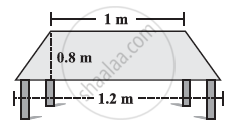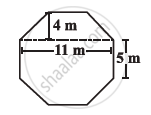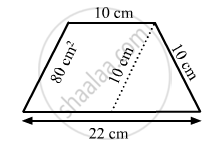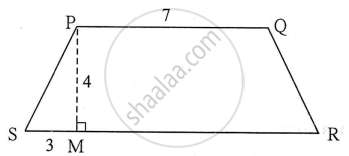Advertisements
Advertisements
Question
Find the area, in square metres, of the trapezium whose bases and altitude is as under:
bases = 28 cm and 3 dm, altitude = 25 cm
Solution
Given:
Bases:
\[28 cm =\frac{28}{100}m = 0.28 m\]
And, 3 dm \[=\frac{3}{10}m = 0.3 m\]
Altitude = 25 cm\[ =\frac{25}{100}m = 0.25 m\]
Area of trapezium \[=\frac{1}{2}\times(\text{ Sum of the bases })\times( \text{ Altitude })\]
\[ = \frac{1}{2} \times (0 . 28 + 0 . 3) m \times (0 . 25) m\]
\[ {= 0.0725 m}^2 \]
APPEARS IN
RELATED QUESTIONS
The shape of the top surface of a table is a trapezium. Find its area if its parallel sides are 1 m and 1.2 m and perpendicular distance between them is 0.8 m.

Top surface of a raised platform is in the shape of a regular octagon as shown in the figure. Find the area of the octagonal surface.

Find the area, in square metres, of the trapezium whose bases and altitude is as under:
bases = 12 dm and 20 dm, altitude = 10 dm
Find the height of a trapezium, the sum of the lengths of whose bases (parallel sides) is 60 cm and whose area is 600 cm2.
In Fig. 20.38, a parallelogram is drawn in a trapezium, the area of the parallelogram is 80 cm2, find the area of the trapezium.
There is a pentagonal shaped park as shown in Fig. 20.50. Jyoti and Kavita divided it in two different ways.
Find the area of this park using both ways. Can you suggest some another way of finding its areas?
Length of the two parallel sides of a trapezium are 8.5 cm and 11.5 cm respectively and its height is 4.2 cm, find its area.
☐ PQRS is an isosceles trapezium l(PQ) = 7 cm. seg PM ⊥ seg SR, l(SM) = 3 cm, Distance between two parallel sides is 4 cm, find the area of ☐ PQRS.

The area of a trapezium is 180 sq.cm and its height is 9 cm. If one of the parallel sides is longer than the other by 6 cm. Find the length of the parallel sides.
A trapezium with 3 equal sides and one side double the equal side can be divided into ______ equilateral triangles of ______ area.
